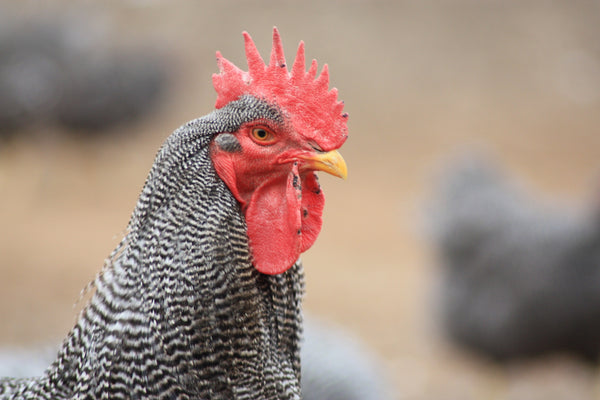
What Separates Heritage Chickens From the Rest of the Pack?
What really separates Heritage Breeds of chicken from the rest of the pack, and why is it so important to help preserve breed diversity?
What is most remarkable about the chicken is that every one of the approximately 12 billion that populate the planet earth are all descended from the Red junglefowl (gallus gallus) of southern Asia.
Of course, counting how many chickens exist is no easy task considering that chicken just surpassed beef as the most eaten meat in the United States. Chickens also live in backyards and rooftops in every country in the world — they only need a small space to provide us with eggs and meat. Sadly many varieties of chicken are on the endangered species list. This cultural loss began in the 1950s but sped up in the 1970s.
Frank Reese and Good Shepherd Ranch are part of an underground movement to preserve old genetics. Today Good Shepherd with Heritage Foods USA is the only company selling 100% USDA inspected factory farm free chicken meat. This means no genetic meddling took place other than preservation of what real chickens once were. No one knows what real chickens are like better than Frank who has been in the business for over 50 years, since he was a little boy. He knows the taste and composition of every chicken that ever walked on American soil. His farm is a museum of the past and if good sense prevails, also the future! Of course no antibiotics are needed on Good Shepherd Ranch because the animals are strong and capable of reproducing on their own. These are chickens with 10,000 year histories.
In an effort promote heritage chickens, Heritage Foods USA is starting to sell ground chicken. This ground can be purchased as part of our livestock variety packs and soon by itself. The delicious ground meat is available in one-pound bags and consists only of heritage birds. Our goal is to increase the market for heritage breeds of chicken, allowing Frank and neighboring farms room to increase various breed populations.
Our whole chicken program continues each season with a rotation of all the breeds that Frank dutifully raises on his ranch. In 2014 the Rhode Island White, Leghorn, Minorca, and White Cornish will have been celebrated on dinner tables around the country. I asked Frank what the differences were between them and he answered, “It’s as big a difference as a Great Dane and a Chihuahua!” We are proud to feature each breed by itself every 3 months as well as breed variety packs that allow you to compare and contrast the flavors and shape of the birds. For a full list of breeds we will feature over the coming months see below. Together we hope to turn the tide against monoculture in the American poultry industry.
Working to change the way Americans eat chicken is no easy task. The industry is dominated by a single variety of chicken that got its start in the 1950s but really became a central actor on the American stage in the 1970s when the folks at Tyson met with the folks at McDonalds to develop the Chicken McNugget. The nugget provided Tyson with a stable and consistent market while also relieving them of the pressures of the fresh poultry market — nuggets could be frozen. Fresh chickens as a dominant part of the industry now became a thing of the past. The nugget created the need for the development of a new industrial hybrid chicken broiler that made the most amount of meat using the least amount of feed. Another goal was that the birds produce almost exclusively white meat even though nature does not do that on its own.
The industry scoured flocks for abnormal candidates to breed together to develop the characteristics they desired, even though it has ultimately been unhealthy for the species. When the industry came across one of nature’s mistakes — say, a chicken so top-heavy with meat that it could barely walk—they pulled it from the flock, not to kill it in an effort to protect the group from bad genes, but to ensure that its abnormal genetics became part of the next year’s harvest. The misfits were cataloged and combined — corporate farms now consist of entire populations who’s skeletal, cardiovascular, and immune systems can’t keep up with their genetic engineering. Long before they got to the crowded feeding ops, these animals were doomed to a life of pain with a potpourri of scurrilous genetics. But boy, do they grow fast! A five-pound chicken has gone from taking 16 weeks to only six weeks to fully grow, but many are on the verge of collapse when they arrive on the kill floor. These are dead end animals.
Thankfully farmers like Frank resisted the trend. His farm consists of dozens of breeds neatly divided in pens. Frank works to improve each genetic line that he has acquired over the past decades. Each breed tastes different but they all boast more dark meat than industrial cousins. They also look like a chicken with thinner breast lines, and a strong build.
The flavor of the meat is intense and the fibers in the meat are very strong and difficult to break down. Heritage chickens must be cooked very low and very slow. Without this technique the birds will be tough. Moisture must also a part of cooking process or else they dry out over the long cooking time.
The breeds Frank raises include Columbian Wyandotte, Rhode Island Whites, Black Leghorns, Golden Penciled Hamburg, Dark Brahma, Silver Laced Wyandotte, White Laced Red Cornish, Dark Cornish, White Cornish, White Jersey Giants, Black Jersey Giants, White Leghorns, Buff Leghorns, Blue Andalusian, Barred Plymouth Rock, Ancona, Light Brown Leghorn, Dark Brown Leghorn, Silber Leghorn, Black Minorca, White Face Black Spanish, Silver Penciled Hamburg, Plymouth Rocks and New Hampshires among many more. We hope you will try each one and help us lay the path for a return of taste and dignity for our animals.





The post What Separates Heritage Chickens From the Rest of the Pack? appeared first on HERITAGE FOODS USA.
